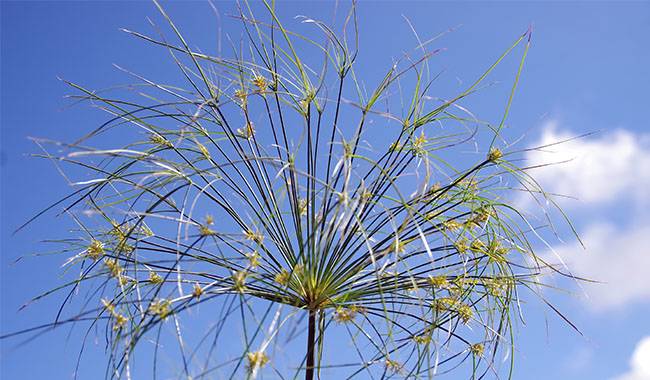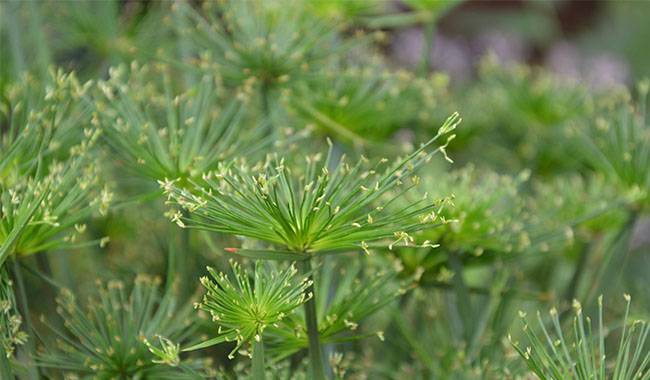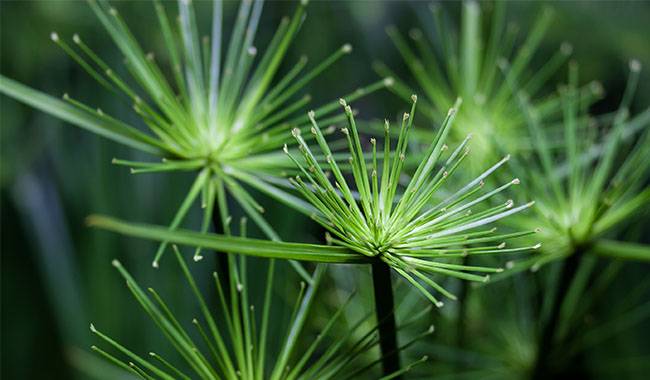
Even compared to other humidity-loving houseplants, Nutsedges is the plant king. It is a true bog plant whose beauty, growth rate, and effectiveness all depend on one factor – humidity. However, Nutsedges is also rightly known as one of the easiest houseplants to grow. If you master this not-so-familiar plant, it will quickly become one of your favorite houseplants. I’ll tell you why you should take a closer look at Nutsedges in this ThumbGarden article.
NUTSEDGES PLANT DESCRIPTION
Indoor Nutsedges is best known for its legendary name “Papyrus”. It captures both the look and character of the plant, albeit in a more compact indoor format. But both the folk garden name papyrus sedges and the botanical cyperus’ are popular.
Nutsedges is a beautiful perennial evergreen herb in the Osocaceae family that grows on dense turf. Depending on the species, Nutsedges reach heights of 12-80 inches (30 cm-2 m.) Nutsedges grow in hollow, round, slender, and straight herbaceous stems of varying sizes and shapes. A perfect umbrella-shaped, flattened whorl of strongly aggregated leaves develops on top of them.
The plant usually looks like a large bundle of green umbrellas unfurling on thin stems. nutsedges leaves are linear with a strong pointed tip. The color is dark.
Nutsedges bloom beautifully, although this characteristic is often underestimated. In the middle of the umbel bloom ventilated, lacy spikes of small white flowers.
TYPES OF INDOOR NUTSEDGES
Nutsedges is the most famous “paper” species, with huge shoots up to 120 inches (3 meters). This plant is bulky and large, requiring large pots for very large greenhouses and conservatories.
Cyperus alternifolius is a vigorous and spreading species. The umbellate stems rise to 40 inches (1 m) tall.
Cyperus involucratus is a large, 40 inches (1 m) long and taller species with wider leaves and huge whorls.
Cyperus gracilis, as we like to call it, is the most compact species with stems up to 15 inches (40 cm) tall with miniature rosettes of thread-like leaves.
GROWING CONDITIONS FOR INDOOR NUTSEDGES PLANTS

The unpretentious Nutsedges will not grow anywhere. They are adaptable and tolerate a little carelessness, but still, need plenty of light to show off their beauty. However, there is little need to worry about temperature.
Lighting and placement
Nutsedges are light-loving. They are best planted in full sun or near a windowsill, or in diffused bright light. Shade is unacceptable and seedlings can gradually “get used to” semi-mountainous areas. It is usually not necessary to adjust the lighting in winter (unless Nutsedges itself signals the opposite by changing the color of the foliage).
Temperature control and ventilation
Cyperus prefers stability. Ideally, its growth will not stop even in winter. Nutsedges need a stable temperature between 68-77 °F (20-25°C). Heat is not good for the leaf tips, but if humidity increases, Nutsedges can easily cope.
On the other hand, cold is the plant’s worst enemy. Nutsedges can only tolerate a drop of 50 °F (10 °C), but it is best to avoid 59 °F (15 °C) and maintain the same room temperature even in winter.
Nutsedges like ventilation and respond well to fresh air, but do not bring plants into the garden, preferably in a room. Allow only slight draughts and no temperature fluctuations. Proximity to a heater will cause the tips of the leaves to dry out more quickly.
CARING FOR NUTSEDGES PLANTS AT HOME

If you recreate a proper “bog” environment with irrigation, the plant will have no problems. Nutsedges is virtually disease-free and always hints at its problems with its foliage.
Watering and air humidity
Nutsedges like wading moisture, constant and high. The soil should not be allowed to dry out, drought is disastrous – all or almost all stems will turn yellow. It is recommended to grow wheatgrass in trays or double containers filled with water. The water level in the outer container will create an optimal condition.
But you can achieve this with a lot of classic watering. Reduce soil moisture only when the temperature drops, do not let the plants dry out completely, but change the watering time or lower the water level in the pot.
Nutsedges are very sensitive to water quality. Neutral, not just standing water, but purified water or rainwater is ideal for Nutsedges that like moisture.
High air humidity is best; it is essential in hot weather. The beauty of greenery will be more fully revealed if a more stable environment can be created by spraying Nutsedges or installing a humidifier. Nutsedges are great for rooms with high natural humidity (such as bathrooms) or with tropical moisture-loving exotic plant communities.
Fertilizer and fertilizer composition
Nutsedges prefer poor soil. In the first year after transplanting, fertilizer can be used without fertilizer. In spring and summer, fertilize by half every 2-3 weeks. If growth does not stop and Nutsedges stays warm, fertilize infrequently, even in autumn and winter, but regularly (once a month).
Pruning and shaping Nutsedges
Nutsedges are easy to rejuvenate and get contained. Simply cut off the oldest umbels or thin the crown and the plant will be completely transformed. The stems are cut all the way to the bottom.
Transplants, containers, and substrates
Repot Nutsedges when the plants have mastered the previous container (horizontally). they need large, very wide pots with good drainage holes.
The soil in which Nutsedges are planted must meet the requirements of a swampy environment – it must be resistant to acidification and compaction, allow regular over-watering of the substrate, and allow good water retention. Only coarse-textured neutral acidic substrates are suitable for Nutsedges. adding coarse sand, perlite, coco soil, and vermiculite will better enhance the general-purpose substrate. Adding charcoal and sphagnum will eliminate the risk of rotting.
Nutsedges are ideal for hydroponics, tanks with automatic irrigation, and for experiments in botanical gardens.
Transplant the plants using the transplant method, separating them if necessary. It is important to keep the plants at the same level and not to flood them. The top of the soil can be covered with moisture-absorbing material.
Pests and problems in cultivation
Nutsedges can only develop various problems if the air and soil humidity is not correct, or if the watering is too acidic or too hard. nutsedges quickly give signals in the form of browning of the leaf tips.
Very rarely, Nutsedges in a neglected state will attract aphids, spider mites, or felt mites. Increasing humidity is usually enough to control, but if the infestation is severe, insecticides are better.
Nutsedges’ reproduction
Only chlorophyll can reproduce more easily than Nutsedges. Each ring of leaves at the top of the stem is a potential new shrub. Sometimes Nutsedges produce aerial roots directly on the umbrella, but any less old umbrella can be rooted in water or soil. Simply cut them down along with the entire stem, shorten the leaves to about half their length, and place them in moist soil or soak them in water until they grow roots.
When repotting, old Nutsedges bushes can be easily separated. When doing so, it is best to cut off or separate the dry parts of the bush and the newly sprouted seedlings can be planted as separate plants.
Nutsedges seeds are rare in the market, but they germinate quickly and easily. They are superficially sown. High humidity and warmth are key parameters.







